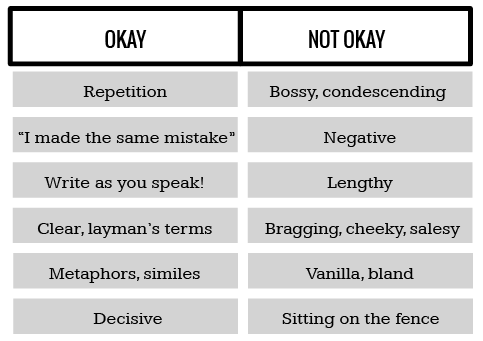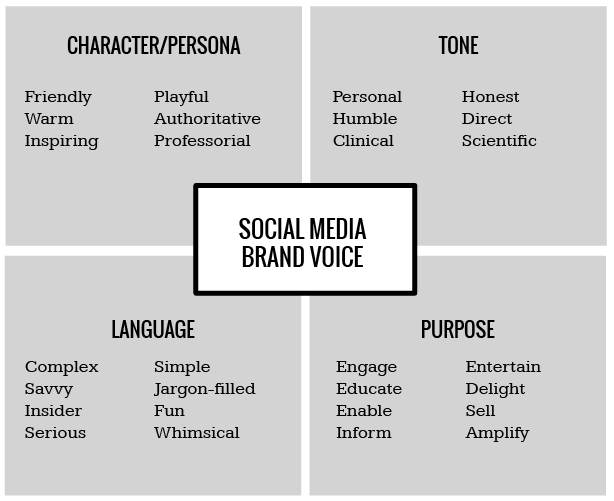These are the things I wanted the world to know:
When I first etched a shaky dark ring around my eye…I’m dramatic.
The daily ritual of shrouding myself in black velvet from head to toe…I’m angsty.
Wearily uttering monosyllables…I’m not dignifying anyone with an answer.
The 14 year old me was a goth. That was the first time I ever defined a brand…and it was my own.
And that’s true for most of us. We begin to create our own brand when we’re teeny teenagers. We forge our own identity. Our way of relating to the world and telling it how to relate to us.
But why do we do this? It’s simple: to stand out and fit in.
A bit of an oxymoron? Yes, but opposites can be striking (think ‘act naturally’, ‘found missing’, ‘deafening silence’).
If you can master differentiating yourself from your competitors and fitting in with your customers’ desires you will be on the road to success.
Although aesthetics are crucial, an integral part of making your brand relatable to your target audience is your tone of voice. What you say and how you say it will make you easily identifiable and can create a powerful identity for all your communications.
NOTE: My 14 year old self took minimalist language to a whole new level and it was equally as powerful as verbose prose (no one loves a monologue-er).
A big faux pas made by businesses is trying to dive straight into creating their brand’s tone of voice, without getting to grips with the fundamentals first. This will leave you with a random tone of voice without any strategy or substance to it. Imagine my goth persona speaking like a Jersey Shore regular.
Follow the basics of brand building and it will lead you to a clearly defined tone of voice that (literally) speaks volumes to your target audience.
So, first…
Why Branding?
Scott Goodson, Founder of Strawberry Frog describes branding like this:
Brands are psychology and science brought together as a promise mark as opposed to a trademark. Products have life cycles. Brands outlive products. Brands convey a uniform quality, credibility and experience.
A brand gives your company a personality. It makes you trustworthy and it helps people identify with you. Your brand is how people feel about you. Given the choice of two similar products with roughly the same price point, the stronger brand will always win the customer.
So…how do you get there?
Get To Know Your Business
Your starting point needs to be a thorough brand exploration that drills down into the details of what makes your brand unique.
For anyone else to understand what makes your business stand out, you need to understand what makes it stand out yourself. To be able to truly recognise and define your USPs.
TRUTHFUL ANALYSIS:
You’re going to have to get real about your company…there’s no point sugarcoating it.
For those of you that haven’t had the pleasure, you’re going to have to get better acquainted with the SWOT and the PESTLE. Each have their own ways of assessing your business, the SWOT internally, the PESTLE externally.
They’re nifty little tools because they allow you to delve into and be realistic about where your business sits in the market, what it’s pitfalls are and where it’s excelling.
Read this handy article by Creately for some SWOT and PESTLE examples to get the ideas flowing.
PVC:
No, we’re not talking about dodgy skin-tight clothing. You’re going to need to define your personality, values and culture before you can work on your tone of voice. How do you know how your company should sound if you don’t know who it is?
It’s an intricate process that takes time and expertise. And the latter, we can provide you with. For in-depth exercises on how to drill down into the details of these, read our FREE ebook ‘The Bull-Free Guide to Branding’.
STALK YOUR COMPETITORS:
Ok, so don’t literally do this. That’s weird. But, you need to complete a thorough competitor analysis to find out exactly where you sit in the marketplace. By analysing your competitors’ positions you’ll be able to make sure you’re entirely unique.
UNIQUE POSITION:
This brings us nicely onto creating your unique position.
You need to be thinking ‘where’s the gap?’
Here’s an example from Volvo: Volvo:
For upscale American families, Volvo is the family automobile that offers maximum safety.
So theirs is maximum safety. They are positioning themselves as the safest car in America.
Remember to always follow these four key elements when creating your brand position:
1. What your product or service is
2. Who your target audience is
3. Why you are better than your competitors
4. What you promise to do
There you have the fundamentals. And you’re ready to let your brand begin to speak.
Toning Your Tone
Now we’re getting to the good stuff. At this point, we get down to the nitty gritty of what all this brand exploration means and how it applies to the real tangible, touchable world.
How, in detail, should you communicate your company to the outside world?
Based on your analysis, PVC, and unique position you can give your tone of voice guidelines to any designer, copywriter or advertising company and they will know exactly how to keep their work for you completely on brand.
Let’s begin with some exercises (of the mind, not the body).
1) Decide on 5 adjectives that cover the main tone for your company
For example: Clever, friendly, educational, clear, inspirational.
If you’re struggling for inspiration, this article by Nelson Nielson Group will give you a helping hand.
2) It’s a great idea to use an “axis”.
By comparing two extremes you can describe the subtle differences in your tone of voice. Using the ‘X’ as your particular point on the axis, here’s an example of how yours might look:
Formal———————————X—————-chatty
Serious————————————-X——-humorous
Detached————————————-X———warm
Professional—————–X————————-casual
Tasteful–X—————————————–unrefined
Wordy—————————————X——–concise
3) Keeping the above in mind, let’s now think of the kind of things you should and should not say/sound like. Yours will be different to the example below, but it’s a good jumping off point.
4) Imagine a character speaking on behalf of your company.
By visualising your tone of voice, it becomes much easier to explain. Some people choose to assign particular famous people or characters. We’ve had Don Draper, Richard Branson and Kate Moss come up in some of our sessions. However, you can also just create your own. For example:
Age: 28 Sex: Male
Profession: Project Manager /Formula 1 fan
Personality traits: Intellectual, individual, reliable, honest, friendly, quick witted, charismatic, confident, opportunistic.
5) What do you want your voice to help your customer with?
Some may be to make them laugh, others will want to reassure. Choose up to ten purposes for your voice. Below there is an example of what we mean.
- To assist
- To simplify their decision
- To light their path
- To convert
- To inform
- To educate
- To build trust
6) Now it’s time to create your own ‘Tone of Voice Matrix’.
This will pull together all of the core attributes of your tone of voice and brand.
The matrix will act as your go-to reference point to ensure all your communications are effective, polished and on brand. Check out the example below and tailor yours similarly.
Now you’ve got that nailed down you should have a pretty good idea of your brand’s personality, tone of voice and overall way of presenting itself to the world.
But before you begin, you should take a peek at some unique brands in action. Check out this article from Marketing Land to see the greats at work. Who knows, you could be on the next list!
Top Tips from Us
Let’s finish off with some takeaway points to keep you on the right track.
REMEMBER TO…
- Talk to ONE person, not the masses. Really talk to them…. Use the words ‘you’ and ‘yours’, and I/we/us etc. Like you’re sitting down and having a chit chat.
- Avoid clichés. Especially those awful corporate, ‘boardroom’ buzzwords and phrases, it really turns people off. But if you replace a word or two in a cliché, it can be a refreshing, powerful change.
- Be conversational. Do you talk like that at home? If not, ditch the flowery or formal language. Unless you’re actually Benedict Cumberbatch, in which case…crack on.
- Ask questions. Why? Well, it makes you feel more engaged, doesn’t it? You feel more like we’re having an actual conversation right now, don’t you? This will help breathe life into your brand identity.
- Talk about benefits AND features (but mostly benefits).Sell a good night’s sleep, not the mattress. Emotional benefits are especially powerful – but DON’T overdo it with B2B. Your readers are marketers too. They’ve heard it all before. And they’re mostly interested in their bottom line. They understand the emotional benefits of getting richer.
- Get inside their mind. It’s a powerful place to be. Say things like ‘I know what you’re thinking’, ‘now, pause for a sec and consider this…’, ‘mull that over’ and ‘let me guess: you’re wondering if…’ etc.
- Build rapport and trust. Be likeable. Don’t dive straight into the hard sale, or the boring facts. Just like a face-to-face salesman, you’ll need to establish that initial connection with your reader. That initial rapport.
- Give your readers commands. Use imperatives. Tell them what to do and what to think (like I’m doing now). This works especially well if you want an authoritative voice. If you want to sound like an expert. A thought-leader.
Say it Loud, Say it Proud
The final stage is of course, putting all of the above into action! Your new tone of voice guidelines should be rolled out across the company so everyone is completely on board. Even employees outside of the marketing department should be aware because it helps to keep your brand consistent.
Also, it’s great for camaraderie, as everyone likes to feel part of something and a newly defined tone of voice will encourage a sense of pride and innate understanding of the business you work for. This will ultimately help communications throughout the company to keep the tone unified.
Think of it this way: if you saw a person you know well speaking in a different accent, in a totally different tone of voice to usual, you’d think they’d lost the plot.
The same can be said for an inconsistent brand.
Be diligent, disciplined and consistent. Make sure every new team member reads your brand bible and it’s easily accessible for all.
Your brand will be unstoppable with a powerful tone of voice. We can tell.
Big love,
Ella


this a nice tool to know the best thing when you are sing or practicing your voice . thank you for sharing this thing Godbless.
Thank you so much!